“The Reservation” — Long Branch’s Cottage Colony
By Michael Sheehan
Going Back 125 Summers …
It’s an amusing tale about a forgotten era in city life. Visitors to the popular Seven Presidents Oceanfront Park in North Long Branch may notice a large house standing alone on the grounds of the county park. But very few know the history behind it.
That “cottage” — as it was known when built — is 125 years old. One of nine stately homes constructed in 1900 by Nathan “Nate” Salsbury, owner and business manager of the legendary Buffalo Bill’s Wild West Show (in one year alone the hit show staged 341 performances in 132 US towns).
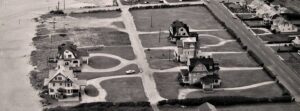
“The Reservation” property looking south, 1970s (Click image to enlarge). The private road in the middle was called “The Trail.”
William F. “Buffalo Bill” Cody (1846-1917) — once the ultimate folk hero of the American west — was the most famous men in the world at the turn of century. He founded his own show, “Buffalo Bill’s Wild West” in 1883, “a circus-like extravaganza that toured widely for three decades in the US and Europe.” As for Salisbury, he had shown early spunk — enlisting in the Union Army at age 15 and fighting in the Civil War. There he learned to be a crack shot and a campgrounds entertainer. Enterprising too, he’d won $20,000 playing cards before he left the service.
Local history on the 16-acre North Long Branch property goes back to 1862 when Aaron Christellar built the 200-room Atlantic Hotel. In 1871, seeking to profit on the Long Branch summer resort boom, Jay Gould and James Fisk acquired the hotel and 50 aces in the area. Renamed the East End Hotel — the developers also built a pier and nearby train depot. The hotel was a bust, Fisk died and Gould left Long Branch is disgust. John Hoey bought the land in 1875 and wrecked the hotel. A.G. Greenberg of New York acquired the property in a sheriff’s auction and Salisbury got it from him.
The group of homes was known as “The Reservation” and with huge profits from the wild west show, Salsbury pledged to spend “every cent in Long Branch,” according to Entertaining a Nation. Each house in the summer settlement was given a number and named in honor of a Native Indian tribe or chief — #1: Cheyenne, #2: Iroquois, #3: Navajo, #4: Arapahoe, #5: Uncapapa, #6: Okachobee #7: Cherokee, #8: Okaliska, and #9: Miami. The name of the last house still standing is Navajo.
The houses were designed by Long Branch architect Leon Cubberley and built by White & Coyne; Jacob Steinbach supplied the furnishings. Each cottage cost between $10,000 and $12,000 and occupancy began in May 1901.
Grand Plans
A shrewd businessman and a tireless promoter, Salsbury marketed the luxury homes as having “a commanding position” on the Long Branch oceanfront, as well as a “superb view” from their upper floors of the highlands of the Navesink and the Shrewsbury rivers, which he claimed were unmatched by any other section of the Jersey Shore. The cottages were only a “brisk” 7-minute walk from the North Long Branch railroad station, according to Salsbury’s prospectus, where frequent trains carried passengers to and from New York City.
Each house came with gas and electric light fixtures, could be wired for telephone service if the resident asked for it, and was connected to city sewers — a big plus. In addition, each family had their own bathhouse and Salsbury emphasized the privacy of The Reservation’s 1,000-yard-long beach frontage, which was for the exclusive use of residents.
The houses were big even by today’s McMansion standards. In addition to a large living room, dining room, and “reception room” or “sea room” on the first floor, each had five bedrooms for residents on the second floor, with another five rooms on the third floor for the servants. Every floor had a “water closet” — a bathroom, to us moderns. In the basement of each house were a kitchen and servants’ dining room, as well as a laundry room. The basement kitchen was connected to a butler’s pantry on the first floor by means of a dumbwaiter, which the cook used to deliver food to the first-floor dining room.
Originally, Salsbury leased the houses, promising renters that he would furnish the homes with “due regard for comfort and utility,” maintain the properties, and pay the water bills. Stables were available for an additional rent, since not all residents required them.
High Living
Built at the pinnacle of Long Branch’s Golden Era, when it was still a favored destination for the rich and famous, the Reservation attracted many distinguished summer residents. In the early years, George B. McClellan, Jr., mayor of New York City and son of the infamous Civil War general and 1864 US presidential candidate, rented a house there. In later years, G.F. Hoffman, founder of Hoffman Beverages of Newark, owned a Res house, as did Clayton B. Jones, chairman of the Board of Managers of the New York Cotton Exchange.
“If there’s a heaven for me, I’m sure it has a beach attached to it.”
—Jimmy Buffet
Another well-known family that summered at “The Res” were the Forans. Known as “Colonel” from his World War I service, Arthur Foran (1882-1961) owned the Foran Foundry & Manufacturing Company in Flemington, NJ, a firm that at one time made virtually every lamppost and manhole cover in New Jersey. He also served as mayor of Flemington and was elected to the NJ State Senate, where he would serve as its Majority Leader and President.
Foran’s oldest son, John Nicholas (1910-1979), known as Nick, went to Hollywood, where he changed his name to Dick Foran and gained fame as an original “Singing Cowboy.” At one time, he was among the nation’s top 10 cowboy-actors, alongside names like Gene Autry, Roy Rogers and Tex Ritter. Another Foran son, Walter, followed in his father’s footsteps, serving in the NJ State Assembly and the State Senate from 1969 until his death in 1986.
Summer Scenes
Over the years, the Reservation’s large homes made for a family-oriented summer paradise. In the late 1920s, two brothers-in-law, both prominent Brooklyn physicians, bought homes at “The Res,” as it had become known. Both had large families — George Sheehan, MD, summered in the house named Okaliska with his wife and 14 children, while his brother-in-law, William Murray Ennis, MD, occupied Uncapapa with his 7 children. The Sheehan cottage was badly damaged in a July 1935 fire and the Ennis house was hit a lightning bolt in June 1944; Dr. Ennis died in December 1947.
In 1939, the Hoffman house burned to the ground, which proved to be a somewhat fortunate accident. The rest of the homeowners formed a consortium to buy the empty lot, which was turned into a ball field. Every summer Sunday it was the scene of a softball game that pitted a team from The Res against one from nearby Allenhurst Beach Club, with spectators enjoying “front-row” seats on the cottages’ spacious porches. Beach parties and cook-outs were other favorite summer activities.
By today’s benchmarks, the costs were absurd — Salsbury built the entire nine-house complex in 1900 for a total of $200,000. The lot that held the Hoffman house sold for $3,000 in 1939, and Dr. Sheehan’s widow sold her house in 1953 for $10,000.
An Illinois native, Salsbury died in December 1902 at age 57 and his daughter, Rachael, sold the houses in January 1920. Long Branch resident Joseph L. Woolley was the Res property superintendent from the beginning until his death in November 1939.
The End
By the early 1970s most of the houses had fallen victim to neglect and weathering. In 1974, the city of Long Branch acquired the property via condemnation; paying $3.6 million and wrecking all the houses except one. The 33-acre property — including nearby White Sands Beach Club — sat idle for several years as the city wrangled with Monmouth County over how it should be used.
Lacking the funds to properly develop the property, the city signed over the title to the county in 1981 but then objected to county plans for a beachfront park that included acquiring an additional 22 acres of land across Ocean Avenue for parking and ancillary services. Eventually, differences were ironed out.
In May 1984, the present day beachfront county park with a 4,700-foot shoreline was formally dedicated. The total project cost $2 million and was mostly funded by Green Acres state grants. The very popular county park is named for the seven American presidents who are said to have “visited Long Branch” — Grant, Hayes, Garfield, Arthur, Harrison, McKinley, and Wilson. A skate-plex center was added in 2005.
Michael Sheehan, the 14th and final child of George and Loretto Sheehan, was a longtime writer and marketing executive. He lived in Monmouth Beach for over 50 years before his death in February 2023.
More Info:
• LOC The Reservation Photos and Drawing — HERE
• Seven Presidents Oceanfront Park — HERE
• Nate Salsbury Helped Buffalo Bill Become the World’s Top Showman — HERE
Images of the Res …
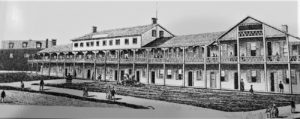
Here First — Atlantic Hotel in North Long Branch. Prior to the cottages and the county, the area first held the Atlantic Hotel. Built in 1862 by Aaron Christellar, it could accommodate 200 guests and catered mostly to Jewish guests. Jay Gould and Jim Fisk acquired the property, made grand renovations and opened the East End Hotel in June 1873. The Gilded Age barons also built a nearby train depot and a pier. It was all a total flop. By 1879, it was called the Arlington House hotel. Hit by a major storm in 1880, the doors shut in 1881. John Hoey bought the property and used old hotel timbers to build his Hollywood Hotel in West End.

“A Veritable Fairyland” — The Reservation sketch layout, 1900. Today, Seven Presidents Park holds the ground.
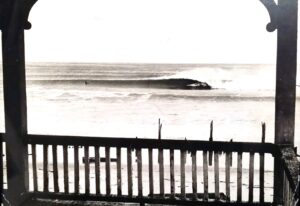
“Point Break Wave“ — View from an old Res house porch of the Kiernan Surfing Association beach with surfer in North End, Winter 1973 (Ted Brantly Photo).
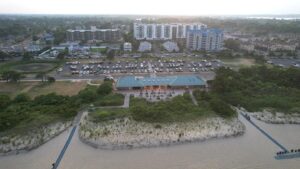
Seven Presidents Oceanfront Park aerial image, Summer 2022 (David Booth Photo). The main beach pavilion was opened for Summer 1984. Fitzpatrick & Associates of Eatontown did the construction.
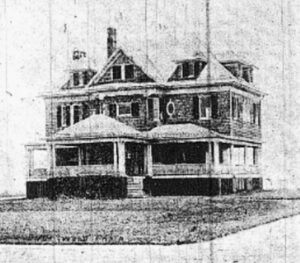
The Res house of George B. McClellan, Jr. The son of the Civil War general and 1864 US presidential candidate, he was mayor of New York City (1904-09).
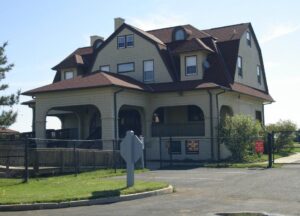
“Navaho” — Seven Presidents Oceanfront Park headquarters, 2013. The first adult season beach badge was $20; the daily weekend rate was $3.
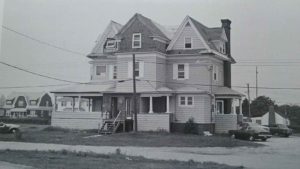
25 Super Summers — Dr. Sheehan’s house at The Res, 1970s. The Brooklyn family owned the North End beach house from 1927 to 1953.
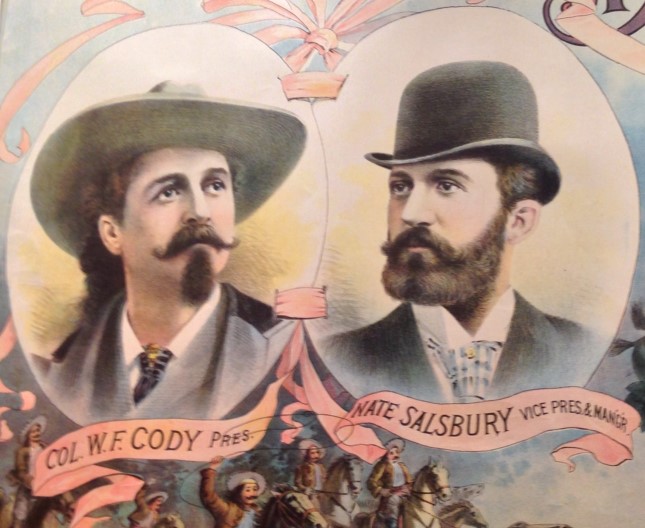

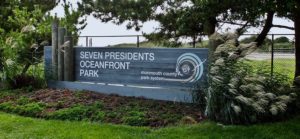

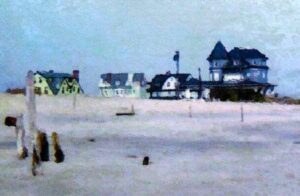
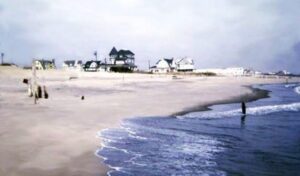
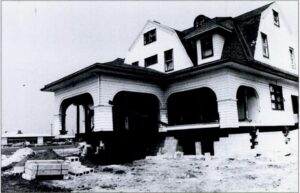
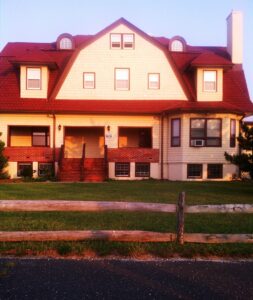
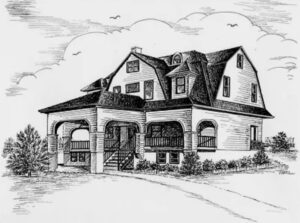
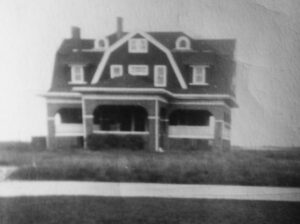
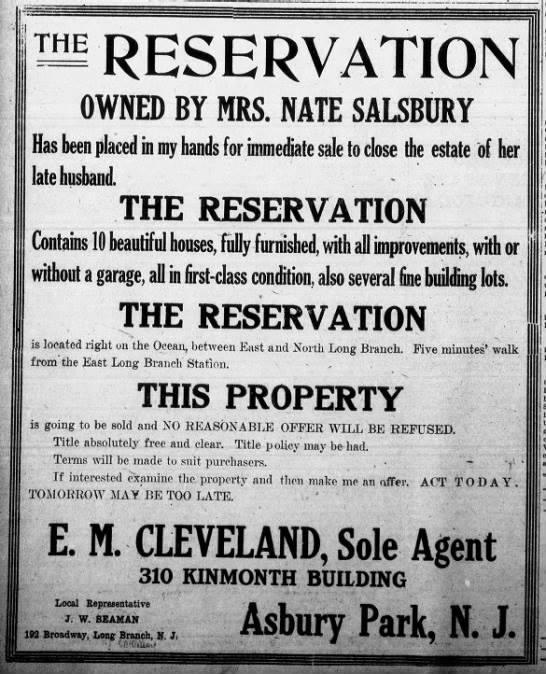

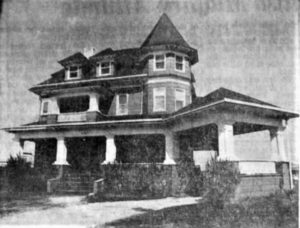
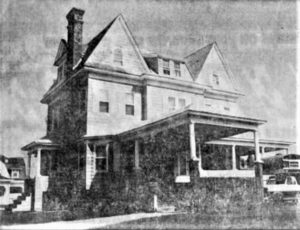
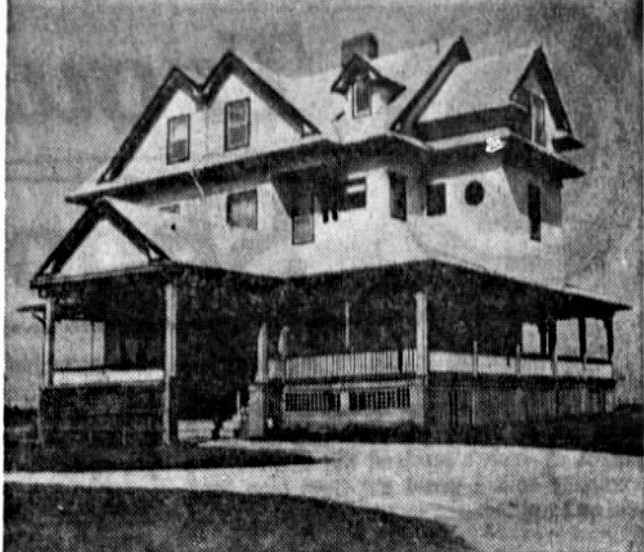
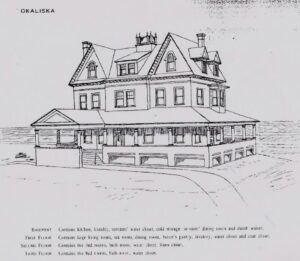
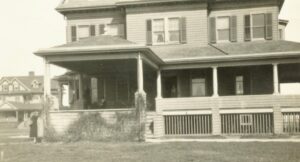

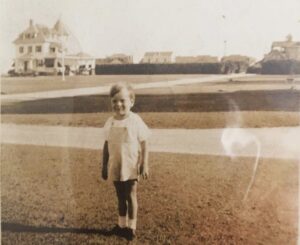

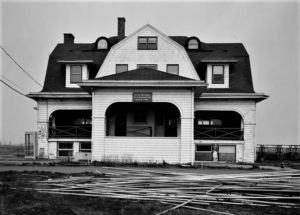

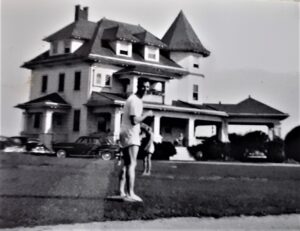


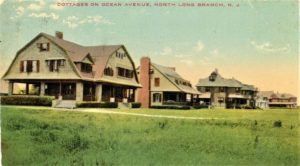
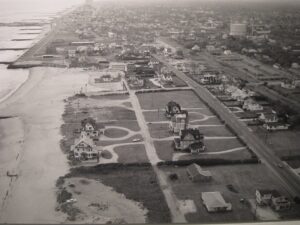
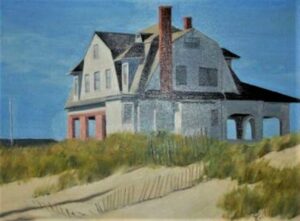
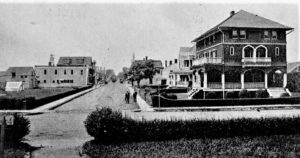

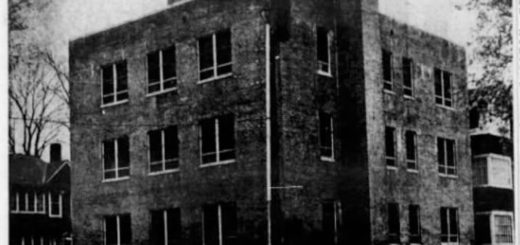
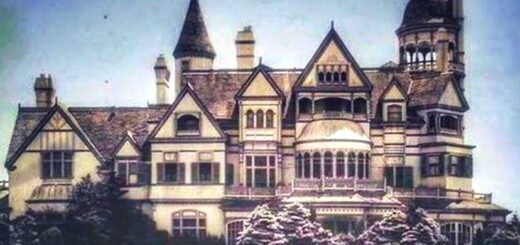

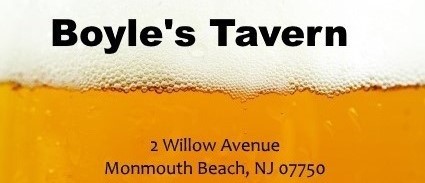
My sister’s best friend in high school was Mary Ellen Cody … a direct descendant of Buffalo Bill Cody. Unfortunately, she passed away at the age of 18, shortly after graduating high school.
Great article Greg yet let us not forget the Kiernan Surfing Association that leased the surfing rights in front of those houses from 1965-1972 from Whitesands Beach Club owner George Savoth.
We have been awarded a monument from Seven Presidents Park commemorating our tenure and status as the first organized surfing club on the Jersey Shore!
And at our 50th Anniversary the city of Long Branch awarded us the key to their city as well as recognizing us and declaring so on their books as June 26th Kiernan Surfing Association Day!
Also, the Historical Society of Long Branch has honored us by having us in for a presentation of our history.
You may Google us to find a plethora of links of our tenure.
Sincerely,
Theo Brantly
Director
732.768.8482
theo.lee3@yahoo.com
https://www.surfksausa.com/membership
My grandparents, Louise and R. Sterling Mueller owned what I think was the “Navaho” in the early-mid 1930s. I believe it’s the last remaining house that was moved. Family photos indicate the houses were not originally painted or perhaps shingles were stained??
“Navahoe” was owned by the Muellers. My older siblings remembered when the Muellers spent summers there but I recall that it was rented every summer. One of the tenants was George Delacorte, founder of Dell Books, a leading publisher of paperbacks.
I was born and raised on this beach and played amongst the Res homes in winter months. My father Charles operated White Sands Beach Club there when he, my mother Inger, and I lived there in the 1960s. We moved out after a hurricane and my father’s brother Georgie moved in, bulldozing what was left of our modest home.
As a matter of fact, I just noticed how the article omitted all references to the time frame my grandfather Charles P. Savoth, I had purchased and owned the entire area of beach upon which he built White Sands Beach Club which my father operated and where we lived until the mid 1960s. It burnt down March 1978. While I believe author Mr. Sheehan’s understandable interest was in his family’s part in the history there, don’t forget us.
On a lighter note, I’d misunderstood for my lifetime until now that the beach actually had the Wild West Show set up and “summer” there, giving them an occasional show. This makes more sense. But as a young boy, it was me and my Danish mother Inger who would wander around those stately old homes, long abandoned but our interest was in the sea — 24/7, 346 days a year, I awoke to the waves and fell asleep the same. It was an idyllic childhood, albeit not festooned and adorned with the trappings of the former Res Jet Set, Hoi Poloi that predated our time there. The Red Barn up the street which I believe the Savoth family owned as well. was a speakeasy in the 1920s, later becoming Chi Chi’s.
My family owned the home at the entrance of Seven Presidents Park — 36 Joline. We were there over 60 years, til eminent domain took our family home!
We would visit the Cincotti’s in the Reservation and Mrs. Ginola who was in front of our house. Charlie and Conover Gaskin and their mom Nicki owned one of the fish stores, and the lemon ice stand. Romano’s and the Lido Hotel were around the corner. So many great memories. The LB Broadway was the best — we even had a dept store, Vogels.
Anyone who remember these things please contact me.
My recollection of the Reservation is of being a guest at John J Merli’s house. I recall a large staircase case down to the beach which was wiped away by a storm. Mr Merli’s house was next door to the Cincotti’s.
The Cincotti’s owned a pastry shop in East Harlem at 116th street and second avenue, New York. The pastries were delicious.